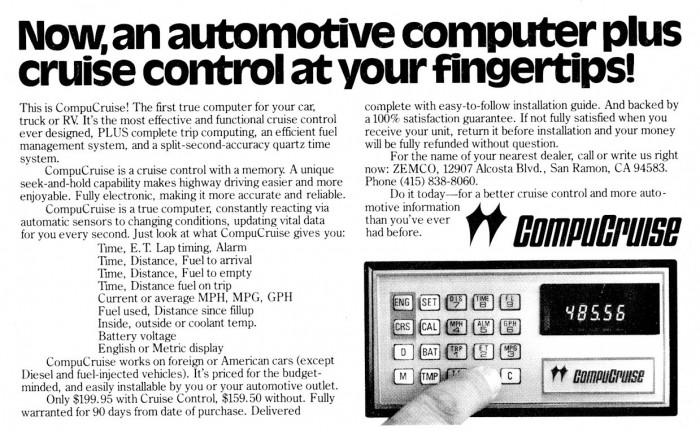Who remembers aftermarket add-on automotive computers like the Zemco CompuCruise?
Posted on Aug 3, 2016 in Featured | 2 comments

Zemco CompuCruise ad.
As a young teenager in the early 1980s, I was already a car guy, despite the fact that I was still too young to drive one. I read car magazines and worked on (more like ruined) the family cars to learn more about repairing and mildly modifying them, adding things like gauges and open-element air cleaners. Simple upgrades I could get away with.
One thing that fascinated me was the new aftermarket automotive computers. Even though I liked fast cars, I also enjoyed the thought of a small add-on computer to track fuel mileage.
Those that I could find were too expensive when I got my license and first car in the mid-1980s, but fairly soon after, I saw a rudimentary MPG computer in the J.C. Whitney catalog for a price I could actually afford. I bought it and installed it in my ’79 Formula in place of the ashtray assembly, since I didn’t smoke, and it fit almost perfectly in that spot.
It worked okay, but didn’t have all the features of my dream onboard aftermarket computer—the Zemco CompuCruise. As you can see in the ad published here, it could seemingly do everything I wanted and more—40+ functions total, according to an August 1980 test in Popular Science. And cruise control was optional. Those prices in the ad are from 1979, and in 1987, I still couldn’t afford it.
I later found one at the Spring Swap Meet at Raceway Park in Old Bridge, New Jersey. It was well used, removed from a car, had lots of wires, none of the sending units I was assuming it needed and no installation instructions. I think it was $15, so I bought it anyway, in the hopes of someday finding the remaining parts and an installation manual. Remember, this was long before the Internet, so none of that ever actually happened.
Today, it is carefully hidden in a box of parts I have yet to locate. Hopefully, I’ll find it someday, so I can at least put it on a shelf for display. I have since located the operating manual online, but not the rest of the parts I need. So, by posting this blog, I’ll attempt to live vicariously through your experiences.





.gif)


Why would it not work on fuel injected vehicles? I presume the sensor for fuel use could not be plugged into the high pressure recirculating fuel injection systems. Anyone know more specifically?
Mechanical fuel injectors had a constant flow of fuel with a return line sending any unused fuel back to the fuel tank it would not measure the fuel used.